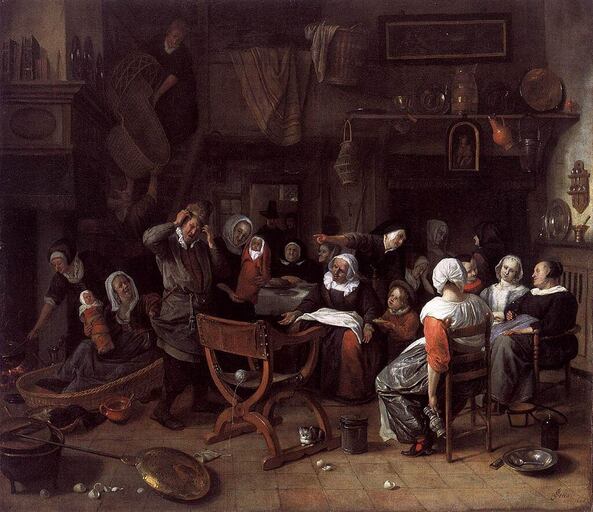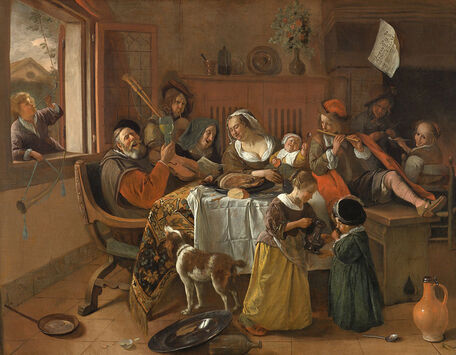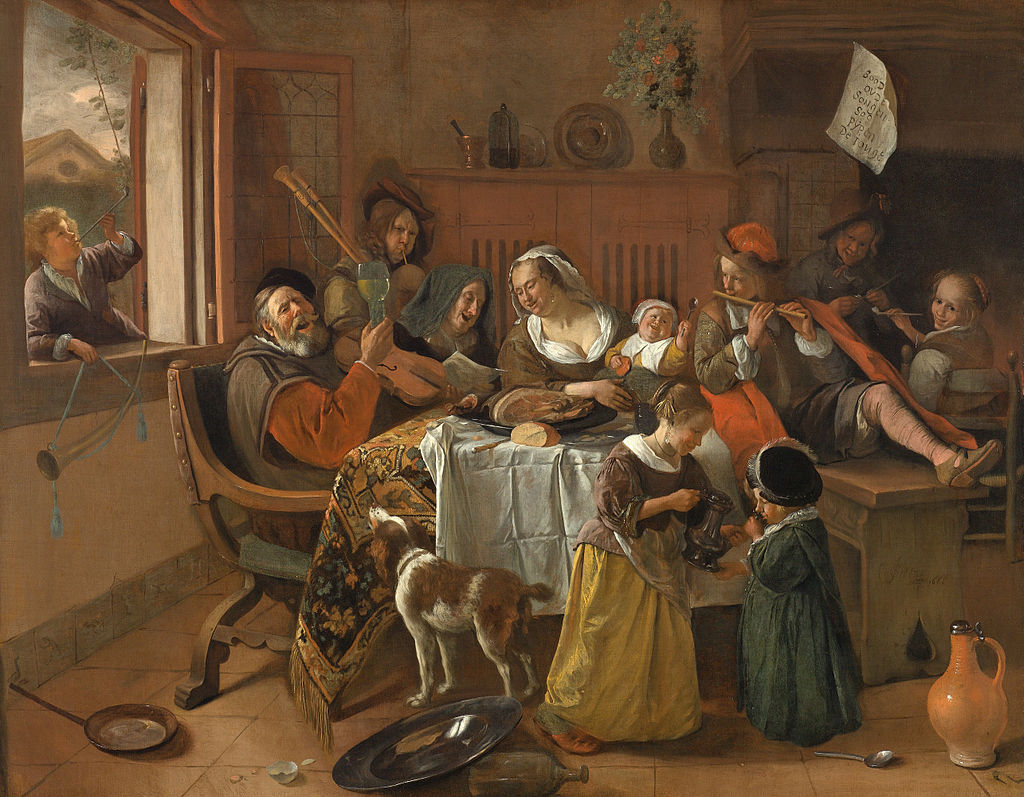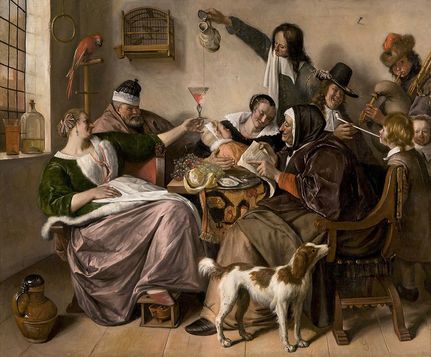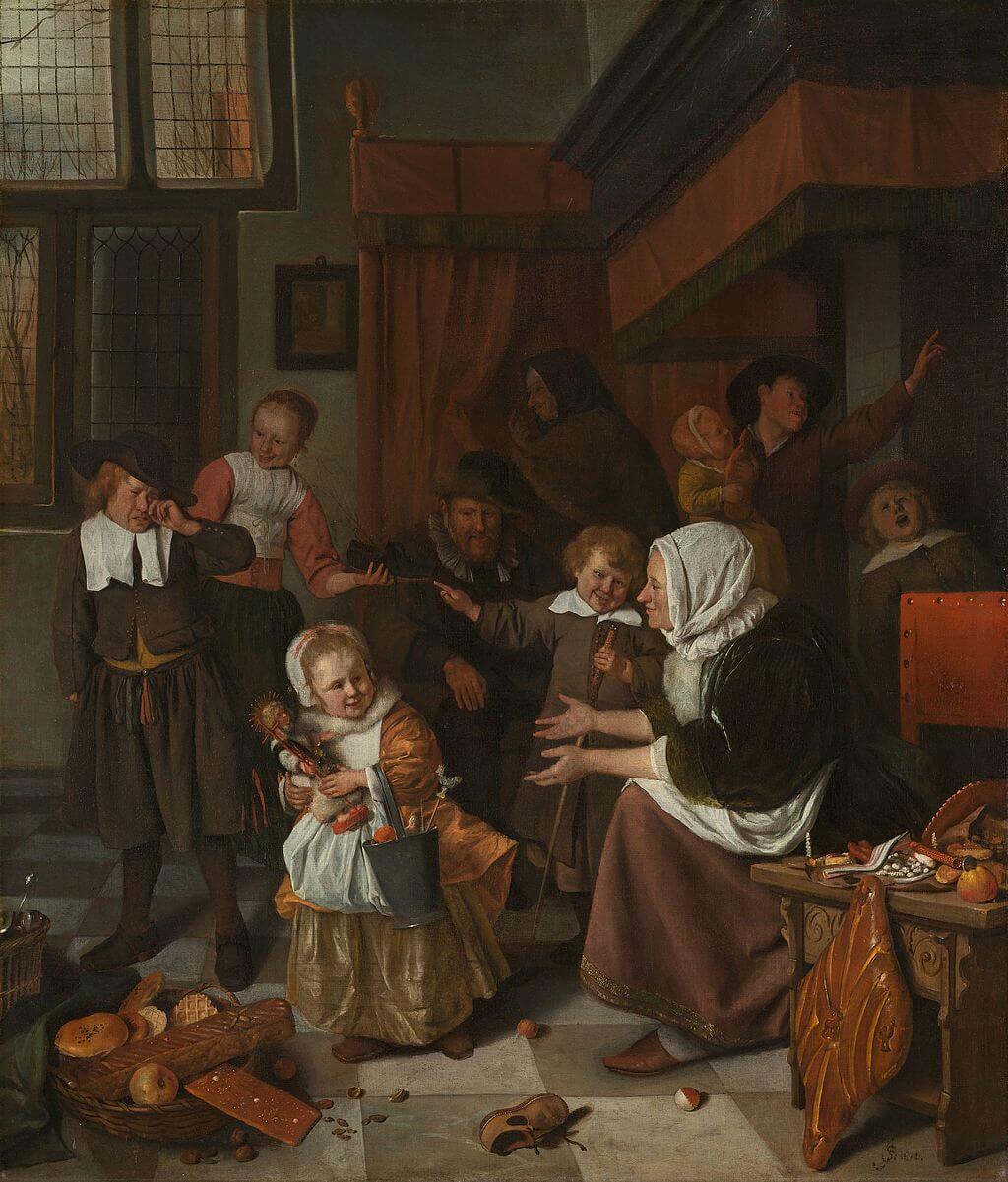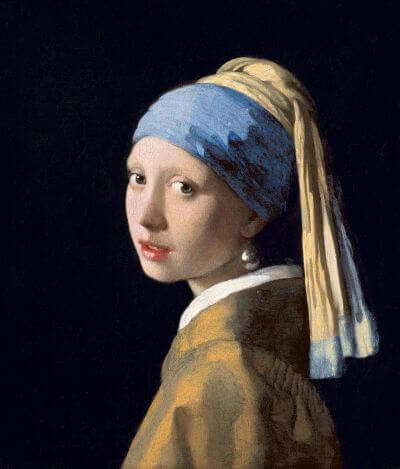|
Where? East Galleries II on the first floor of the Wallace Collection
When? 1664 What do you see? A party to celebrate the arrival of a newborn baby. In the middle, a father holds his newborn. He wears a so-called kraamherenmuts, a typical cap worn by new fathers. On the left, the mother lays in her bed (below the canopy on the top left). Friends and family surround the father and baby. The scene is chaotic but happy. People engage in all sorts of activities, and bowls, pans, plates, egg shells, and food are scattered throughout the room. In the foreground, a maid is shown from the back. She is dressed in happy colors and holds a red chair for the father to sit in. The woman standing on the right side (from our point of view) from the father will receive some money from the father who puts his left hand in a money bag. In the right foreground, a smiling woman is stirring in a large pot and holds up her hand to receive some money as well. Another woman helps her pouring sugar into the pot. The maid on the right is getting a sausage that hangs from the chimney. On the left, two people are paying attention to the mother, and one of them feeds her some soup. To the left of the table, a pregnant woman sits next to a crib. She holds a glass in her left hand and conceals her belly with a white apron. Backstory: This painting has been known under several titles, including The Christening, The Christening Feast, and The Gossiping. Steen signed the painting by writing JSteen.1664 above the door. In addition, the long-haired man behind the father may be a self-portrait of Jan Steen. The painting has been altered a bit over time, but a large cleaning in 1983 removed some of the 19th-century additions. For example, you can still see that the plate in the hand of the woman on the right (getting the sausage) was originally larger. Sir Richard Wallace acquired the painting on May 15, 1872. Jan Steen made several other paintings about the celebration of the birth of a child. For example, in 1668, he painted Twin Birth Celebration, which is in the Kunsthalle in Hamburg.
Symbolism: The marriage between the husband and wife is not good as there are hints that both are cheating on each other (see the fun fact below for more on this). The broken egg shells in the foreground could both symbolize the lack of sexual intercourse within the marriage and sexual intercourse outside the marriage (also notice the bits of egg yolk on the floor). The eggs were also used to produce an alcoholic cinnamon-based drink which was a traditional drink for the mother to recover from the childbirth.
The item on the bottom left, which looks like a frying pan, is a bed warmer. It refers again to the bad state of the marriage as the bed warmer indicates the only warmth there is in bed. Furthermore, the sausage hanging on the top right is also a sexual reference. Steen wanted to remind people with this painting of the importance of a good marriage. Who is Steen? Jan Havickszoon Steen (1626-1679) was a painter from The Netherlands who is best known for the comical and ironic themes in his paintings. His works often include chaotic scenes from everyday life. Typical examples are The Merry Family in the Rijksmuseum in Amsterdam and Rhetoricians at the Window in the Philadelphia Museum of Art. However, he was quite versatile and also created mythological, religious, still-life, and portrait paintings. Jan Steen was the son-in-law of Jan van Goyen, a successful landscape painter from the 17th century. Steen did not always earn enough money with his paintings and ran a brewery and an inn at different points in his life. Observing people having some drinks must have been a great inspiration for Steen as this is a theme that he frequently incorporated in his paintings.
Fun fact: Typical for Jan Steen, this painting contains some comical details, but at the same time these details completely change the meaning of the painting. For example, look right above the head of the baby. A man is raising his two fingers, which was a sign of infidelity. It is a sign that the man raising his fingers is the birth father of the child, while the man holding the baby is only the official father (as his wife has cheated on him). The woman on the right with the large breasts jokingly opens her hand to receive some money from the father. She may be the midwife, but also a little bit more than that…
Interested in a copy for yourself? Poster or canvas.
0 Comments
Where? The Eregallerij on the second floor of the Rijksmuseum
When? 1668 What do you see? A happy household in a messy living room. The mother is sitting in the middle of the table and holds a young child on her lap. She is singing with her own mother next to her and shows a large amount of cleavage. The father on the left of the table is singing loudly as well and raises his glass while holding a violin in his left hand. The boy outside the window is smoking a pipe while he is holding a horn in his right hand. In the foreground, the young boy in green is drinking wine, which is provided to him by his sister who is holding a jug of wine. Both of them look older than their height would indicate. Two other children are playing music. The boy on the right with the red hat is playing the flute, and the boy in the left background is playing a kind of bagpipes. On the right background, a boy and a girl are holding pipes with tobacco. The dog is standing in front of the table which is filled with bread and meat, and he hopes that some of the food will fall off. The floor in the living room is messy, and we can identify a frying pan, half an eggshell, a large bowl, two jugs and a spoon. In contrast, the objects on top of the painting are neatly organized. On the top right, Steen included a piece of paper stating: ‘“Soo d’ oude Songen, Soo Pypen de Jonge.’ This means ‘As the Old Sing, So Pipe the Young.’ Backstory: Jan Steen sometimes used his own family as models for some people in his paintings, and it is suggested that some of the children in this painting are modeled after his kids. Steen created quite some paintings of families or groups of people in a messy environment. These paintings were not necessarily a realistic depiction of life in The Netherlands during the 17th century, but for Steen, it was a way in which he could include his style of humor and irony, but still provide a moral message. For example, some comparable paintings to The Merry Family are As the Old Sing, So Pipe the Young in the Mauritshuis in The Hague and The Feast of Saint Nicholas in the Rijksmuseum.
Moral message: Steen usually included a moral message in his paintings and he more often used children to convey this message. The behavior of the children in this painting is not intended to make you laugh, but to make you evaluate the behavior of their parents.
The message written on the piece of paper emphasizes that as it mentions that children are just copying the behavior of their parents. This message refers to the behavior of both parents and the grandmother, but primarily to the mother as, during that time, she was the main responsible for the moral values in the family. So, the moral message of this painting is that the people should be careful in the way they behave as it may have a big impact on (their) children. Who is Steen? Jan Havickszoon Steen (1626-1679) was born in Leiden in The Netherlands. During his life, he lived in various other Dutch cities, including The Hague, Delft, Warmond, and Haarlem. While Jan Steen also painted biblical, historical, and mythological scenes, his most popular works are the scenes from daily life. Steen is known for his humoristic style of painting, and he often included a moral message in his paintings, sometimes based on proverbs from his time. He is also considered to be an expert in accurately incorporating light into his paintings. While Steen has not had any known pupils, two of his sons were painters, but none of their works have survived. Fun fact: In Dutch, there is an expression for a messy and cluttered interior, which is still used nowadays. The Dutch expression is ‘een huishouden van Jan Steen’, which means ‘a Jan Steen household’. The people living in such a household are often depicted as happy people, just like in this painting. Jan Steen created quite some paintings that show these messy scenes, either depicting a family household in the living room or a group of people in a tavern. Jan Steen's messy households are in stark contrast to the very calm and organized paintings by his contemporary Johannes Vermeer, known of paintings such as Girl with a Pearl Earring in the Mauritshuis and The Milkmaid, which is also in the Rijksmuseum.
Where? Gallery 264 of the Philadelphia Museum of Art
When? 1658-1665 What do you see? A window with at least five men who seem to be enjoying themselves (it seems that there is a sixth man on the top right, but he is not clearly visible). These men are members of the chamber of rhetoric, which is a society of amateur poets and performers, and these societies existed in Belgium and The Netherlands since the 15th century. On the left, a man is enthusiastically singing from a paper entitled ‘lof liet’, which is Dutch for ‘song of praise’. The person standing behind him has created this song. Behind them stands a man who is drinking. The person sitting in the right window is critically listening to the song. He is firmly holding a jug that probably contains wine. He is wearing a hat with a pipe attached to it. Behind him is a so-called jester wearing a red cap. He is entertaining the crowd (which you cannot see, but who are also listening to this performance) and puts up his finger to capture their attention. On top of the window grows a vine with ripe grapes. Below the window hangs the emblem of this chamber of rhetoricians, which includes a glass of wine and two crossed pipes. Backstory: Jan Steen painted the rhetoricians more often during his career. In this painting, it is unclear whether Steen wanted to show his appreciation for the rhetoricians or whether he is somewhat sarcastic in the way he depicts them due to the many references to drinking. Steen created several other paintings featuring the rhetoricians. The painting Rhetoricians of Steen is currently in Museum Bredius in The Hague. The Feast of the Chamber of Rhetoricians near a Town-Gate is in a private collection. The Rhetoricians - In Liefde Vrij is in the Royal Museums of Fine Arts of Belgium in Brussels.
Symbolism: The people in this painting show different emotions. Some believe that this painting expresses the four temperaments:
Chamber of rhetoricians: This society was a popular one in Belgium and The Netherlands since the 15th century. They existed both in large cities and small towns and focused on poetry and drama. They were often depicted, by artists like Jan Steen, as people that primarily liked to drink large quantities of wine. However, in reality, these societies were a little bit more serious and also provided cultural experiences for the common people by organizing plays and poetry contests. Their performances focused on providing morals to the people and stimulating the audience intellectually. However, as indicated by the emblem in this painting, the chamber was also a social place where members drank wine and engaged in discussions. Who is Steen? Jan Havickszoon Steen was born in Leiden, The Netherlands, in 1626, and also died there in 1679. He lived at the same time as Rembrandt. Steen came from a family of brewers, which may explain the abundance of alcohol in some of his paintings (which also includes alcohol consumption by children, like in his painting The Merry Family in the Rijksmuseum). He is also known to drink quite a bit himself. Steen is considered a genre painter as he often depicted scenes from everyday life. However, he has also created some paintings with biblical, mythological, and historical themes. He often incorporated some humor in his paintings, is known for his colorful paintings, and his contemporaries appreciated his works. Steen created many paintings during his life, and over 300 of them have survived.
Fun fact: In the 17th century, people consumed a lot of alcohol as the water quality was poor and alcoholic beverages were much safer to drink. Alcohol was even served in both the Catholic and Protestant church. Drinking was an important part of the many guilds and societies in the Dutch Republic during this time. Festivals were organized by all the guilds and societies, and usually, the emphasis of these festivals was on excessive drinking and eating.
It seems that the members of the chamber of rhetoricians drank more than average and drinking was an important part of their meetings. Drinking was also one of the more common themes of their poems and plays, and when they performed for an audience, drinks were always nearby. |
Categories
All
|
- Home
- Blog
-
Museums
- Alte Pinakothek
- Art Institute of Chicago
- Baltimore Museum of Art
- Barber Institute of Fine Arts
- Bargello
- Barnes Foundation
- British Museum
- Church of Sant’Anastasia
- Cleveland Museum of Art
- Courtauld Institute of Art
- Detroit Institute of Arts
- Frans Hals Museum
- Galleria Borghese
- Gallerie dell'Accademia
- Getty Museum
- Guggenheim
- Hermitage Museum
- Kunsthistorisches Museum
- Kunstmuseum Basel
- Legion of Honor Museum
- Louvre
- Mauritshuis
- Metropolitan Museum of Art
- Musee d’Orsay
- Museum of Fine Arts in Boston
- Museum of Modern Art
- National Gallery in London
- National Gallery of Art
- National Museum in Poznań
- Norton Simon Museum
- Ny Carlsberg Glyptotek
- Palace of Versailles
- Palazzo Pitti
- Palazzo Vecchio
- Petit Palais
- Philadelphia Museum of Art
- Prado
- Pushkin Museum
- Ravenna Art Museum
- Rijksmuseum
- San Diego Museum of Art
- Santa Maria delle Grazie
- St. Peter's Basilica
- Städel Museum
- Statens Museum for Kunst
- Tate Britain
- Tate Modern
- Timken Museum of Art
- Uffizi
- Vatican Museums
- Wallace Collection
-
Artists
- Altdorfer
- Anguissola
- Berlin Painter
- Bosch
- Botticelli
- Boucher
- Bronzino
- Bruegel the Elder
- Brunelleschi
- Cabanel
- Caillebotte
- Canova
- Caravaggio
- Carpeaux
- Cezanne
- Cimabue
- David
- Degas
- Delacroix
- De Maria
- Donatello
- El Greco
- Fontana
- Fra Angelico
- Fragonard
- Gauguin
- Gentileschi
- Gericault
- Gonzalez-Torres
- Goya
- Hals
- Hogarth
- Hokusai
- Ingres
- Leonardo da Vinci
- Lippi, Filippo
- Longhi, Barbara
- Lorrain
- Makovsky
- Manet
- Massys
- Matisse
- Merian
- Michelangelo
- Mochi
- Modigliani
- Monet
- Panini
- Parmigianino
- Perugino
- Picasso
- Pisanello
- Raphael
- Rembrandt
- Renoir
- Reynolds
- Rivera
- Rodin
- Rubens
- Scultori
- Seurat
- Steen
- Tintoretto
- Titian
- Toulouse-Lautrec
- Turner
- Uccello
- Van der Weyden
- Van Dyck
- Van Eyck
- Van Gogh
- Van Hemessen
- Vasari
- Velazquez
- Vermeer
- Veronese
- Vigée Le Brun
-
Locations
- Books
- About Us


